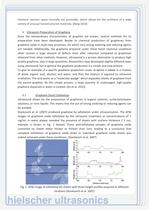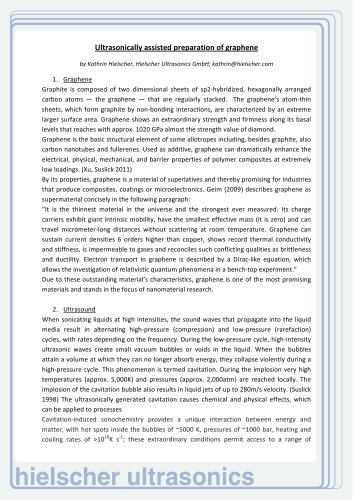 Website:
Hielscher
Website:
Hielscher
Catalog excerpts

Ultrasonically assisted preparation of graphene by Kathrin Hielscher, Hielscher Ultrasonics GmbH; kathrin@hielscher.com 1. Graphene Graphite is composed of two dimensional sheets of sp2-hybridized, hexagonally arranged carbon atoms — the graphene — that are regularly stacked. The graphene’s atom-thin sheets, which form graphite by non-bonding interactions, are characterized by an extreme larger surface area. Graphene shows an extraordinary strength and firmness along its basal levels that reaches with approx. 1020 GPa almost the strength value of diamond. Graphene is the basic structural element of some allotropes including, besides graphite, also carbon nanotubes and fullerenes. Used as additive, graphene can dramatically enhance the electrical, physical, mechanical, and barrier properties of polymer composites at extremely low loadings. (Xu, Suslick 2011) By its properties, graphene is a material of superlatives and thereby promising for industries that produce composites, coatings or microelectronics. Geim (2009) describes graphene as supermaterial concisely in the following paragraph: “It is the thinnest material in the universe and the strongest ever measured. Its charge carriers exhibit giant intrinsic mobility, have the smallest effective mass (it is zero) and can travel micrometer-long distances without scattering at room temperature. Graphene can sustain current densities 6 orders higher than copper, shows record thermal conductivity and stiffness, is impermeable to gases and reconciles such conflicting qualities as brittleness and ductility. Electron transport in graphene is described by a Dirac-like equation, which allows the investigation of relativistic quantum phenomena in a bench-top experiment.” Due to these outstanding material’s characteristics, graphene is one of the most promising materials and stands in the focus of nanomaterial research. 2. Ultrasound When sonicating liquids at high intensities, the sound waves that propagate into the liquid media result in alternating high-pressure (compression) and low-pressure (rarefaction) cycles, with rates depending on the frequency. During the low-pressure cycle, high-intensity ultrasonic waves create small vacuum bubbles or voids in the liquid. When the bubbles attain a volume at which they can no longer absorb energy, they collapse violently during a high-pressure cycle. This phenomenon is termed cavitation. During the implosion very high temperatures (approx. 5,000K) and pressures (approx. 2,000atm) are reached locally. The implosion of the cavitation bubble also results in liquid jets of up to 280m/s velocity. (Suslick 1998) The ultrasonically generated cavitation causes chemical and physical effects, which can be applied to processes Cavitation-induced sonochemistry provides a unique interaction between energy and matter, with hot spots inside the bubbles of ~5000 K, pressures of ~1000 bar, heating and cooling rates of >1010K s-1; these extraordinary conditions permit access to a range of [Text eingeben]
Open the catalog to page 1
chemical reaction space normally not accessible, which allows for the synthesis of a wide variety of unusual nanostructured materials. (Bang 2010) 3. Ultrasonic Preparation of Graphene Since the extraordinary characteristics of graphite are known, several methods for its preparation have been developed. Beside to chemical production of graphenes from graphene oxide in multi-step processes, for which very strong oxidizing and reducing agents are needed. Additionally, the graphene prepared under these harsh chemical conditions often contain a large amount of defects even after reduction...
Open the catalog to page 2
3.2. Preparation of Graphene Sheets Stengl et al. have shown the successful preparation of pure graphene sheets in large quantities during the production of nonstoichiometric TiO2 graphene nanocomposit by thermal hydrolysis of suspension with graphene nanosheets and titania peroxo complex. The pure graphene nanosheets were produced from natural graphite using a high intensity cavitation field generated by Hielscher’s ultrasonic processor UIP1000hd in a high-pressure ultrasonic reactor at 5 bar. The graphene sheets obtained, with high specific surface area and unique electronic properties,...
Open the catalog to page 3
3.4. Functionalization of Graphene Sheets Xu and Suslick (2011) describe a convenient one-step method for the preparation of polystyrene functionalized graphite. In their study, they used graphite flakes and styrene as basic raw material. By sonicating the graphite flakes in styrene (a reactive monomer), the ultrasound irradiation resulted in the mechanochemical exfoliation of graphite flakes into single-layer and few-layer graphene sheets. Simultaneously, the functionalization of the graphene sheets with the polystyrene chains has been achieved. The same process of functionalization can be...
Open the catalog to page 4
Fig.3: Synthesis of Carbon Nanoscrolls (Viculis et al. 2003) 4. Graphene Dispersions The dispersion grade of graphene and graphene oxide is extremely important to use the full potential of graphene with its specific characteristics. If graphene is not dispersed under controlled conditions, the polydispersity of graphene dispersion can lead to unpredictable or nonideal behavior once it is incorporated into devices since the properties of graphene vary as a function of its structural parameters. Sonication is a proven treatment to weaken the interlayer forces and allows for an accurate...
Open the catalog to page 5
indicated that the ultrasonic preparation method has less damage to the chemical and crystal structures of graphene. 5. Potential Applications Biological applications: An example for ultrasonic graphene preparation and its biological In the study “Synthesis of Graphene-Gold Nanocomposites via Sonochemical Reduction” by Park et al. (2011), a nanocomposite from reduced graphene oxide - gold (Au) nanoparticles was synthesized by simultaneously reducing the gold ions and depositing gold nanoparticles on the surface of the reduced graphene oxide simultaneously. To facilitate the reduction of...
Open the catalog to page 6All Hielscher catalogs and technical brochures
-
Ultrasonic Process Lab
1 Pages
-
Ultrasonic Wire Cleaning
4 Pages
-
Ultrasonic Applications
1 Pages
-
Hielscher Ultrasonic Sieves
2 Pages



















